Psychology Report: Lived Experiences of Mentally Disordered Offenders
VerifiedAdded on 2020/05/28
|9
|2287
|101
Report
AI Summary
This report presents a qualitative phenomenological study on the lived experiences of mentally disordered offenders with dual diagnosis. The research, employing the interpretative phenomenological analysis (IPA) method, explores the complexities of this psychological condition, which involves co-occurring mental illness and substance use disorder. The study, conducted with a sample of five participants, delves into their perceptions of self, substance abuse, and recovery strategies. Key findings reveal participants' struggles with self-fragmentation, the integration of social aspects of addiction, and the importance of self-discovery in rehabilitation. The report highlights the significance of understanding the interplay between mental health, substance abuse, and criminal behavior to improve clinical interventions and support the recovery of individuals with dual diagnosis.

Running head: PSYCHOLOGY
Psychology
Name of Student
Name of the University
Author Note
Psychology
Name of Student
Name of the University
Author Note
Paraphrase This Document
Need a fresh take? Get an instant paraphrase of this document with our AI Paraphraser
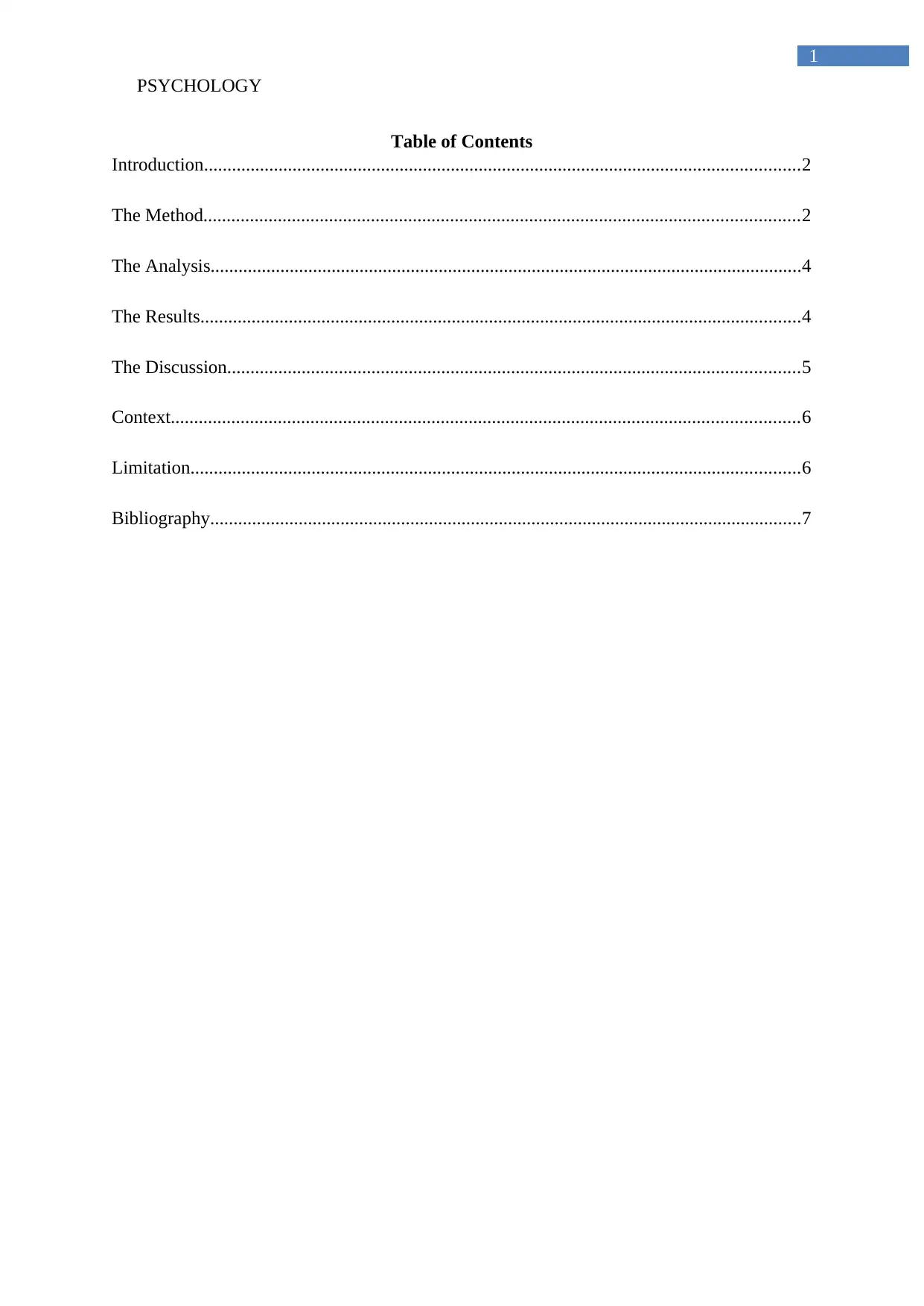
1
PSYCHOLOGY
Table of Contents
Introduction................................................................................................................................2
The Method................................................................................................................................2
The Analysis...............................................................................................................................4
The Results.................................................................................................................................4
The Discussion...........................................................................................................................5
Context.......................................................................................................................................6
Limitation...................................................................................................................................6
Bibliography...............................................................................................................................7
PSYCHOLOGY
Table of Contents
Introduction................................................................................................................................2
The Method................................................................................................................................2
The Analysis...............................................................................................................................4
The Results.................................................................................................................................4
The Discussion...........................................................................................................................5
Context.......................................................................................................................................6
Limitation...................................................................................................................................6
Bibliography...............................................................................................................................7
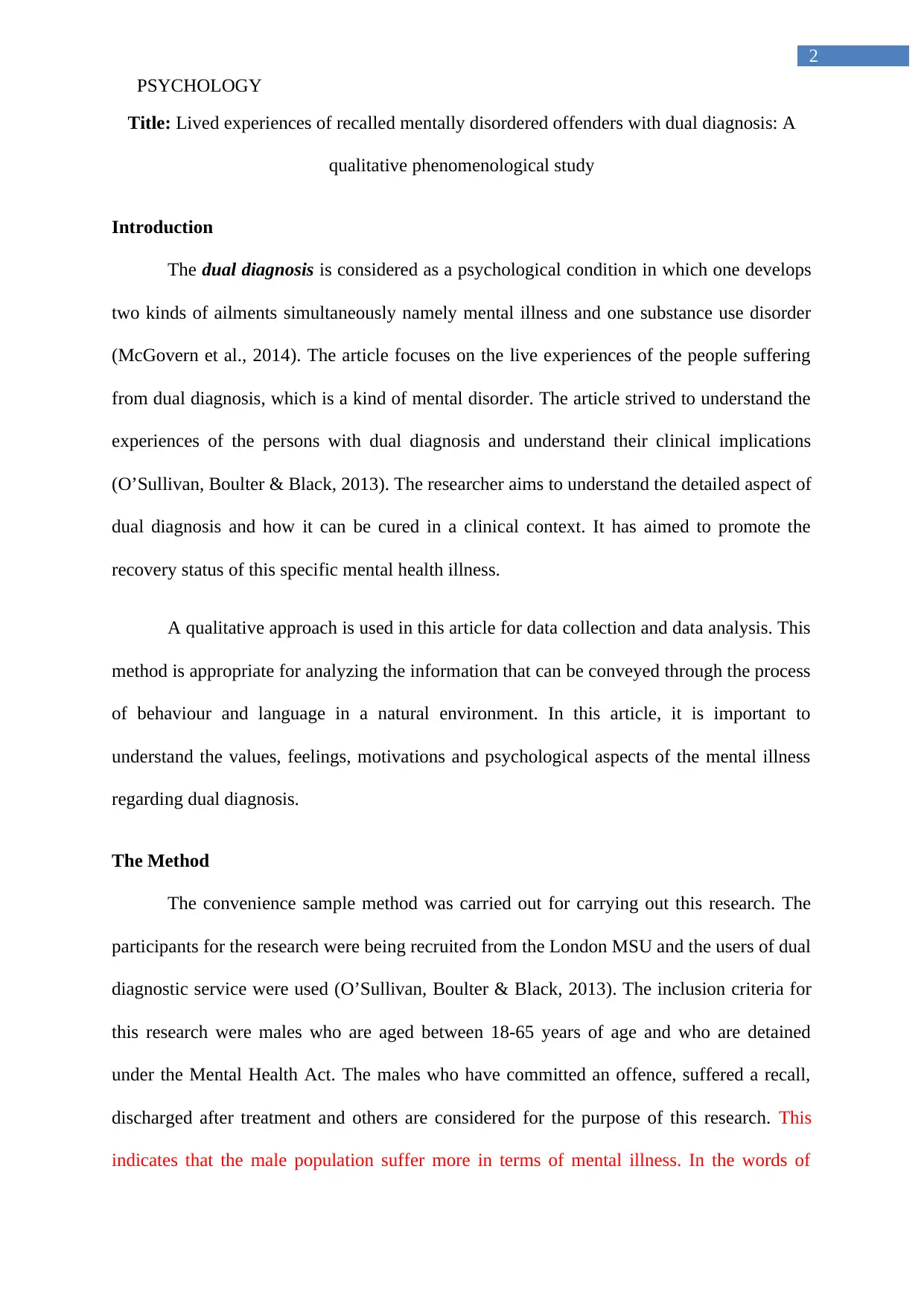
2
PSYCHOLOGY
Title: Lived experiences of recalled mentally disordered offenders with dual diagnosis: A
qualitative phenomenological study
Introduction
The dual diagnosis is considered as a psychological condition in which one develops
two kinds of ailments simultaneously namely mental illness and one substance use disorder
(McGovern et al., 2014). The article focuses on the live experiences of the people suffering
from dual diagnosis, which is a kind of mental disorder. The article strived to understand the
experiences of the persons with dual diagnosis and understand their clinical implications
(O’Sullivan, Boulter & Black, 2013). The researcher aims to understand the detailed aspect of
dual diagnosis and how it can be cured in a clinical context. It has aimed to promote the
recovery status of this specific mental health illness.
A qualitative approach is used in this article for data collection and data analysis. This
method is appropriate for analyzing the information that can be conveyed through the process
of behaviour and language in a natural environment. In this article, it is important to
understand the values, feelings, motivations and psychological aspects of the mental illness
regarding dual diagnosis.
The Method
The convenience sample method was carried out for carrying out this research. The
participants for the research were being recruited from the London MSU and the users of dual
diagnostic service were used (O’Sullivan, Boulter & Black, 2013). The inclusion criteria for
this research were males who are aged between 18-65 years of age and who are detained
under the Mental Health Act. The males who have committed an offence, suffered a recall,
discharged after treatment and others are considered for the purpose of this research. This
indicates that the male population suffer more in terms of mental illness. In the words of
PSYCHOLOGY
Title: Lived experiences of recalled mentally disordered offenders with dual diagnosis: A
qualitative phenomenological study
Introduction
The dual diagnosis is considered as a psychological condition in which one develops
two kinds of ailments simultaneously namely mental illness and one substance use disorder
(McGovern et al., 2014). The article focuses on the live experiences of the people suffering
from dual diagnosis, which is a kind of mental disorder. The article strived to understand the
experiences of the persons with dual diagnosis and understand their clinical implications
(O’Sullivan, Boulter & Black, 2013). The researcher aims to understand the detailed aspect of
dual diagnosis and how it can be cured in a clinical context. It has aimed to promote the
recovery status of this specific mental health illness.
A qualitative approach is used in this article for data collection and data analysis. This
method is appropriate for analyzing the information that can be conveyed through the process
of behaviour and language in a natural environment. In this article, it is important to
understand the values, feelings, motivations and psychological aspects of the mental illness
regarding dual diagnosis.
The Method
The convenience sample method was carried out for carrying out this research. The
participants for the research were being recruited from the London MSU and the users of dual
diagnostic service were used (O’Sullivan, Boulter & Black, 2013). The inclusion criteria for
this research were males who are aged between 18-65 years of age and who are detained
under the Mental Health Act. The males who have committed an offence, suffered a recall,
discharged after treatment and others are considered for the purpose of this research. This
indicates that the male population suffer more in terms of mental illness. In the words of
⊘ This is a preview!⊘
Do you want full access?
Subscribe today to unlock all pages.

Trusted by 1+ million students worldwide
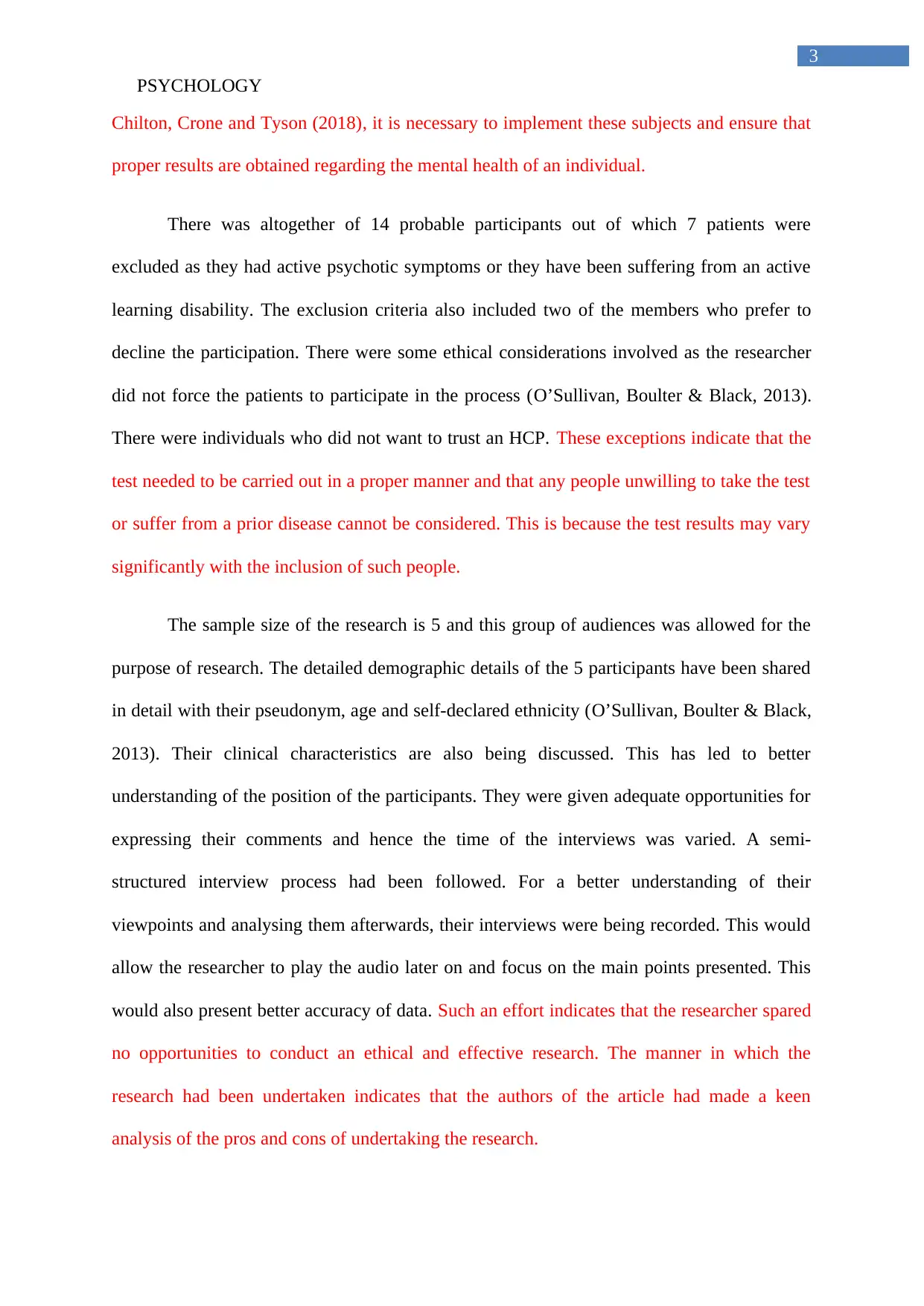
3
PSYCHOLOGY
Chilton, Crone and Tyson (2018), it is necessary to implement these subjects and ensure that
proper results are obtained regarding the mental health of an individual.
There was altogether of 14 probable participants out of which 7 patients were
excluded as they had active psychotic symptoms or they have been suffering from an active
learning disability. The exclusion criteria also included two of the members who prefer to
decline the participation. There were some ethical considerations involved as the researcher
did not force the patients to participate in the process (O’Sullivan, Boulter & Black, 2013).
There were individuals who did not want to trust an HCP. These exceptions indicate that the
test needed to be carried out in a proper manner and that any people unwilling to take the test
or suffer from a prior disease cannot be considered. This is because the test results may vary
significantly with the inclusion of such people.
The sample size of the research is 5 and this group of audiences was allowed for the
purpose of research. The detailed demographic details of the 5 participants have been shared
in detail with their pseudonym, age and self-declared ethnicity (O’Sullivan, Boulter & Black,
2013). Their clinical characteristics are also being discussed. This has led to better
understanding of the position of the participants. They were given adequate opportunities for
expressing their comments and hence the time of the interviews was varied. A semi-
structured interview process had been followed. For a better understanding of their
viewpoints and analysing them afterwards, their interviews were being recorded. This would
allow the researcher to play the audio later on and focus on the main points presented. This
would also present better accuracy of data. Such an effort indicates that the researcher spared
no opportunities to conduct an ethical and effective research. The manner in which the
research had been undertaken indicates that the authors of the article had made a keen
analysis of the pros and cons of undertaking the research.
PSYCHOLOGY
Chilton, Crone and Tyson (2018), it is necessary to implement these subjects and ensure that
proper results are obtained regarding the mental health of an individual.
There was altogether of 14 probable participants out of which 7 patients were
excluded as they had active psychotic symptoms or they have been suffering from an active
learning disability. The exclusion criteria also included two of the members who prefer to
decline the participation. There were some ethical considerations involved as the researcher
did not force the patients to participate in the process (O’Sullivan, Boulter & Black, 2013).
There were individuals who did not want to trust an HCP. These exceptions indicate that the
test needed to be carried out in a proper manner and that any people unwilling to take the test
or suffer from a prior disease cannot be considered. This is because the test results may vary
significantly with the inclusion of such people.
The sample size of the research is 5 and this group of audiences was allowed for the
purpose of research. The detailed demographic details of the 5 participants have been shared
in detail with their pseudonym, age and self-declared ethnicity (O’Sullivan, Boulter & Black,
2013). Their clinical characteristics are also being discussed. This has led to better
understanding of the position of the participants. They were given adequate opportunities for
expressing their comments and hence the time of the interviews was varied. A semi-
structured interview process had been followed. For a better understanding of their
viewpoints and analysing them afterwards, their interviews were being recorded. This would
allow the researcher to play the audio later on and focus on the main points presented. This
would also present better accuracy of data. Such an effort indicates that the researcher spared
no opportunities to conduct an ethical and effective research. The manner in which the
research had been undertaken indicates that the authors of the article had made a keen
analysis of the pros and cons of undertaking the research.
Paraphrase This Document
Need a fresh take? Get an instant paraphrase of this document with our AI Paraphraser
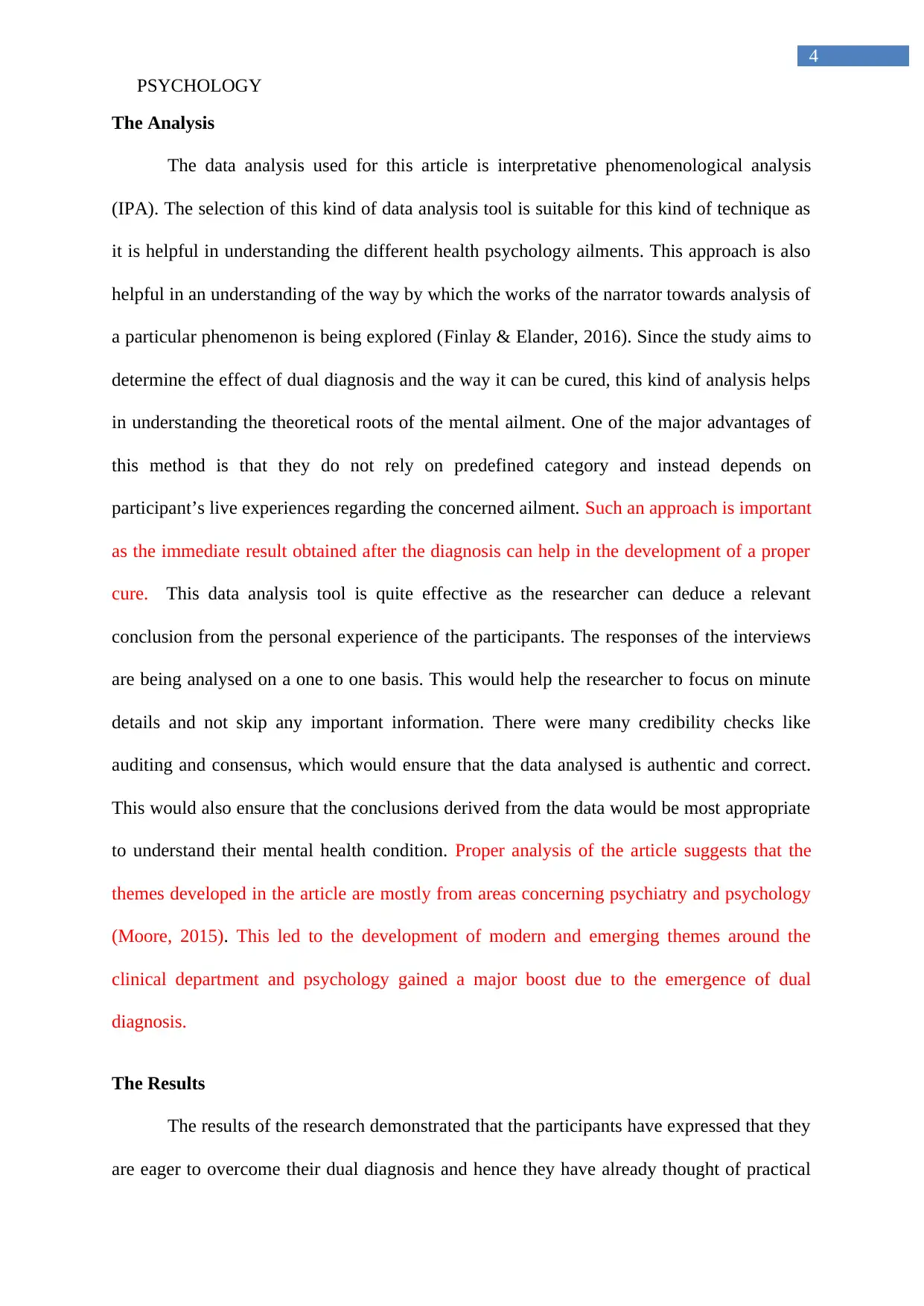
4
PSYCHOLOGY
The Analysis
The data analysis used for this article is interpretative phenomenological analysis
(IPA). The selection of this kind of data analysis tool is suitable for this kind of technique as
it is helpful in understanding the different health psychology ailments. This approach is also
helpful in an understanding of the way by which the works of the narrator towards analysis of
a particular phenomenon is being explored (Finlay & Elander, 2016). Since the study aims to
determine the effect of dual diagnosis and the way it can be cured, this kind of analysis helps
in understanding the theoretical roots of the mental ailment. One of the major advantages of
this method is that they do not rely on predefined category and instead depends on
participant’s live experiences regarding the concerned ailment. Such an approach is important
as the immediate result obtained after the diagnosis can help in the development of a proper
cure. This data analysis tool is quite effective as the researcher can deduce a relevant
conclusion from the personal experience of the participants. The responses of the interviews
are being analysed on a one to one basis. This would help the researcher to focus on minute
details and not skip any important information. There were many credibility checks like
auditing and consensus, which would ensure that the data analysed is authentic and correct.
This would also ensure that the conclusions derived from the data would be most appropriate
to understand their mental health condition. Proper analysis of the article suggests that the
themes developed in the article are mostly from areas concerning psychiatry and psychology
(Moore, 2015). This led to the development of modern and emerging themes around the
clinical department and psychology gained a major boost due to the emergence of dual
diagnosis.
The Results
The results of the research demonstrated that the participants have expressed that they
are eager to overcome their dual diagnosis and hence they have already thought of practical
PSYCHOLOGY
The Analysis
The data analysis used for this article is interpretative phenomenological analysis
(IPA). The selection of this kind of data analysis tool is suitable for this kind of technique as
it is helpful in understanding the different health psychology ailments. This approach is also
helpful in an understanding of the way by which the works of the narrator towards analysis of
a particular phenomenon is being explored (Finlay & Elander, 2016). Since the study aims to
determine the effect of dual diagnosis and the way it can be cured, this kind of analysis helps
in understanding the theoretical roots of the mental ailment. One of the major advantages of
this method is that they do not rely on predefined category and instead depends on
participant’s live experiences regarding the concerned ailment. Such an approach is important
as the immediate result obtained after the diagnosis can help in the development of a proper
cure. This data analysis tool is quite effective as the researcher can deduce a relevant
conclusion from the personal experience of the participants. The responses of the interviews
are being analysed on a one to one basis. This would help the researcher to focus on minute
details and not skip any important information. There were many credibility checks like
auditing and consensus, which would ensure that the data analysed is authentic and correct.
This would also ensure that the conclusions derived from the data would be most appropriate
to understand their mental health condition. Proper analysis of the article suggests that the
themes developed in the article are mostly from areas concerning psychiatry and psychology
(Moore, 2015). This led to the development of modern and emerging themes around the
clinical department and psychology gained a major boost due to the emergence of dual
diagnosis.
The Results
The results of the research demonstrated that the participants have expressed that they
are eager to overcome their dual diagnosis and hence they have already thought of practical
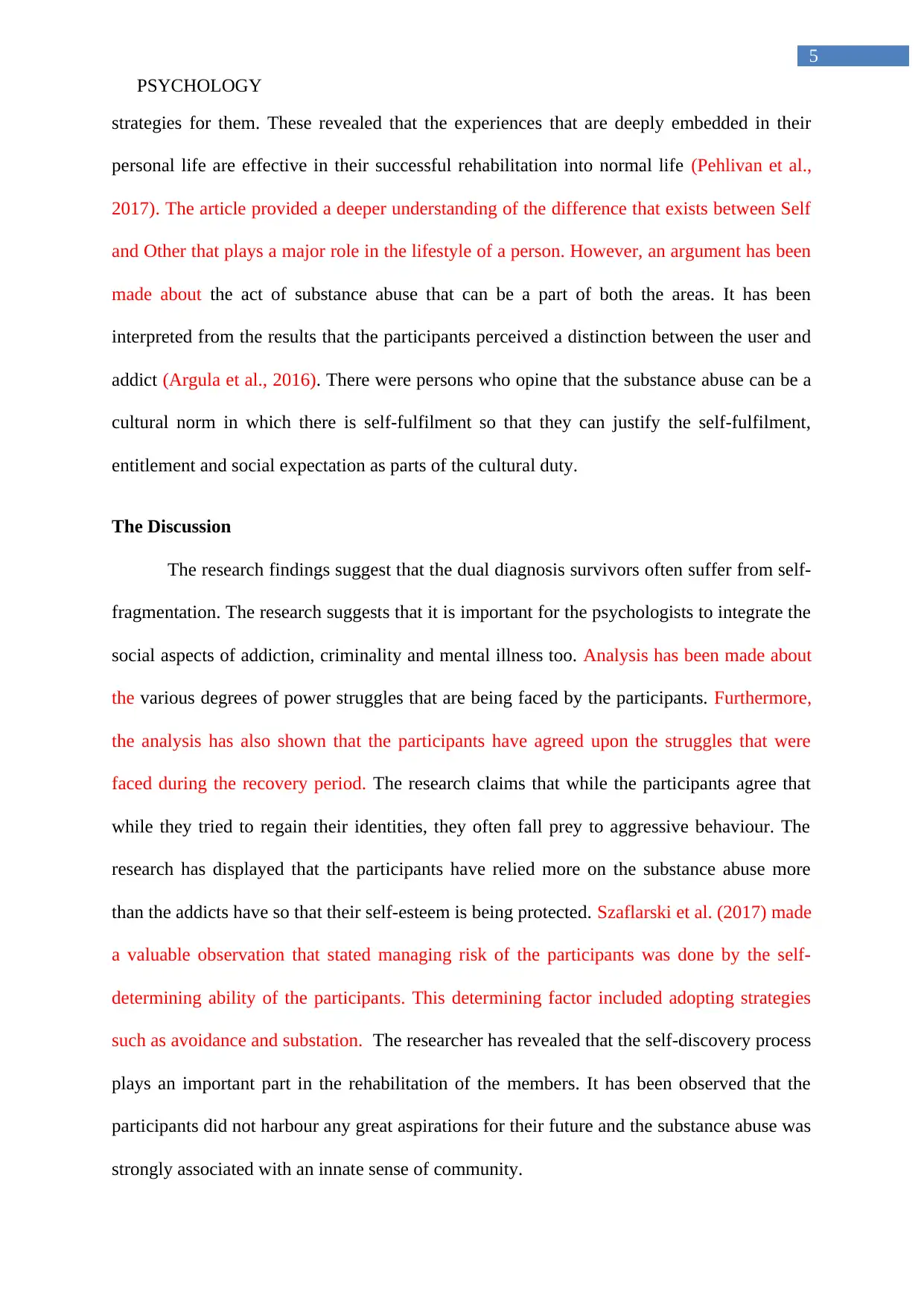
5
PSYCHOLOGY
strategies for them. These revealed that the experiences that are deeply embedded in their
personal life are effective in their successful rehabilitation into normal life (Pehlivan et al.,
2017). The article provided a deeper understanding of the difference that exists between Self
and Other that plays a major role in the lifestyle of a person. However, an argument has been
made about the act of substance abuse that can be a part of both the areas. It has been
interpreted from the results that the participants perceived a distinction between the user and
addict (Argula et al., 2016). There were persons who opine that the substance abuse can be a
cultural norm in which there is self-fulfilment so that they can justify the self-fulfilment,
entitlement and social expectation as parts of the cultural duty.
The Discussion
The research findings suggest that the dual diagnosis survivors often suffer from self-
fragmentation. The research suggests that it is important for the psychologists to integrate the
social aspects of addiction, criminality and mental illness too. Analysis has been made about
the various degrees of power struggles that are being faced by the participants. Furthermore,
the analysis has also shown that the participants have agreed upon the struggles that were
faced during the recovery period. The research claims that while the participants agree that
while they tried to regain their identities, they often fall prey to aggressive behaviour. The
research has displayed that the participants have relied more on the substance abuse more
than the addicts have so that their self-esteem is being protected. Szaflarski et al. (2017) made
a valuable observation that stated managing risk of the participants was done by the self-
determining ability of the participants. This determining factor included adopting strategies
such as avoidance and substation. The researcher has revealed that the self-discovery process
plays an important part in the rehabilitation of the members. It has been observed that the
participants did not harbour any great aspirations for their future and the substance abuse was
strongly associated with an innate sense of community.
PSYCHOLOGY
strategies for them. These revealed that the experiences that are deeply embedded in their
personal life are effective in their successful rehabilitation into normal life (Pehlivan et al.,
2017). The article provided a deeper understanding of the difference that exists between Self
and Other that plays a major role in the lifestyle of a person. However, an argument has been
made about the act of substance abuse that can be a part of both the areas. It has been
interpreted from the results that the participants perceived a distinction between the user and
addict (Argula et al., 2016). There were persons who opine that the substance abuse can be a
cultural norm in which there is self-fulfilment so that they can justify the self-fulfilment,
entitlement and social expectation as parts of the cultural duty.
The Discussion
The research findings suggest that the dual diagnosis survivors often suffer from self-
fragmentation. The research suggests that it is important for the psychologists to integrate the
social aspects of addiction, criminality and mental illness too. Analysis has been made about
the various degrees of power struggles that are being faced by the participants. Furthermore,
the analysis has also shown that the participants have agreed upon the struggles that were
faced during the recovery period. The research claims that while the participants agree that
while they tried to regain their identities, they often fall prey to aggressive behaviour. The
research has displayed that the participants have relied more on the substance abuse more
than the addicts have so that their self-esteem is being protected. Szaflarski et al. (2017) made
a valuable observation that stated managing risk of the participants was done by the self-
determining ability of the participants. This determining factor included adopting strategies
such as avoidance and substation. The researcher has revealed that the self-discovery process
plays an important part in the rehabilitation of the members. It has been observed that the
participants did not harbour any great aspirations for their future and the substance abuse was
strongly associated with an innate sense of community.
⊘ This is a preview!⊘
Do you want full access?
Subscribe today to unlock all pages.

Trusted by 1+ million students worldwide
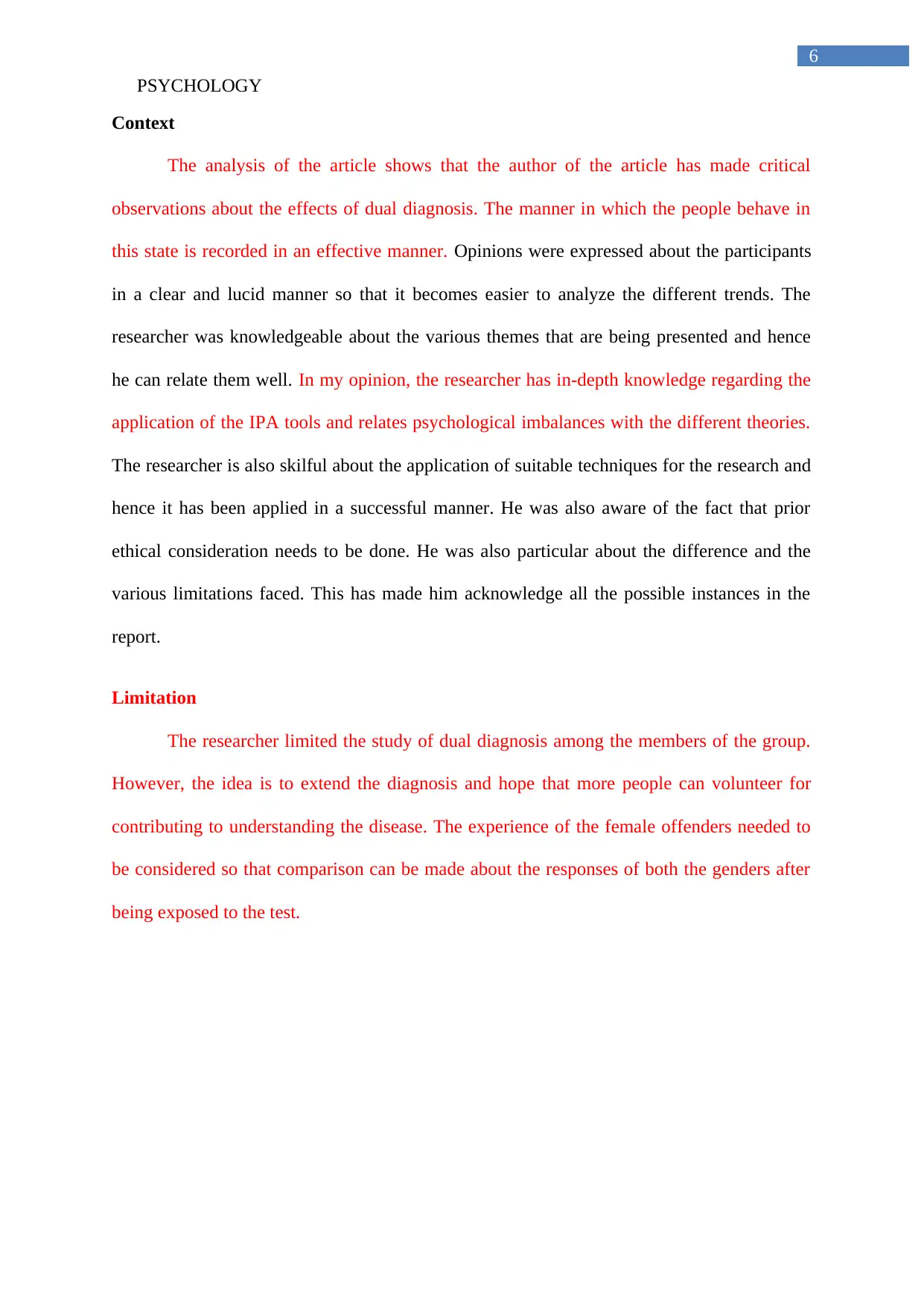
6
PSYCHOLOGY
Context
The analysis of the article shows that the author of the article has made critical
observations about the effects of dual diagnosis. The manner in which the people behave in
this state is recorded in an effective manner. Opinions were expressed about the participants
in a clear and lucid manner so that it becomes easier to analyze the different trends. The
researcher was knowledgeable about the various themes that are being presented and hence
he can relate them well. In my opinion, the researcher has in-depth knowledge regarding the
application of the IPA tools and relates psychological imbalances with the different theories.
The researcher is also skilful about the application of suitable techniques for the research and
hence it has been applied in a successful manner. He was also aware of the fact that prior
ethical consideration needs to be done. He was also particular about the difference and the
various limitations faced. This has made him acknowledge all the possible instances in the
report.
Limitation
The researcher limited the study of dual diagnosis among the members of the group.
However, the idea is to extend the diagnosis and hope that more people can volunteer for
contributing to understanding the disease. The experience of the female offenders needed to
be considered so that comparison can be made about the responses of both the genders after
being exposed to the test.
PSYCHOLOGY
Context
The analysis of the article shows that the author of the article has made critical
observations about the effects of dual diagnosis. The manner in which the people behave in
this state is recorded in an effective manner. Opinions were expressed about the participants
in a clear and lucid manner so that it becomes easier to analyze the different trends. The
researcher was knowledgeable about the various themes that are being presented and hence
he can relate them well. In my opinion, the researcher has in-depth knowledge regarding the
application of the IPA tools and relates psychological imbalances with the different theories.
The researcher is also skilful about the application of suitable techniques for the research and
hence it has been applied in a successful manner. He was also aware of the fact that prior
ethical consideration needs to be done. He was also particular about the difference and the
various limitations faced. This has made him acknowledge all the possible instances in the
report.
Limitation
The researcher limited the study of dual diagnosis among the members of the group.
However, the idea is to extend the diagnosis and hope that more people can volunteer for
contributing to understanding the disease. The experience of the female offenders needed to
be considered so that comparison can be made about the responses of both the genders after
being exposed to the test.
Paraphrase This Document
Need a fresh take? Get an instant paraphrase of this document with our AI Paraphraser
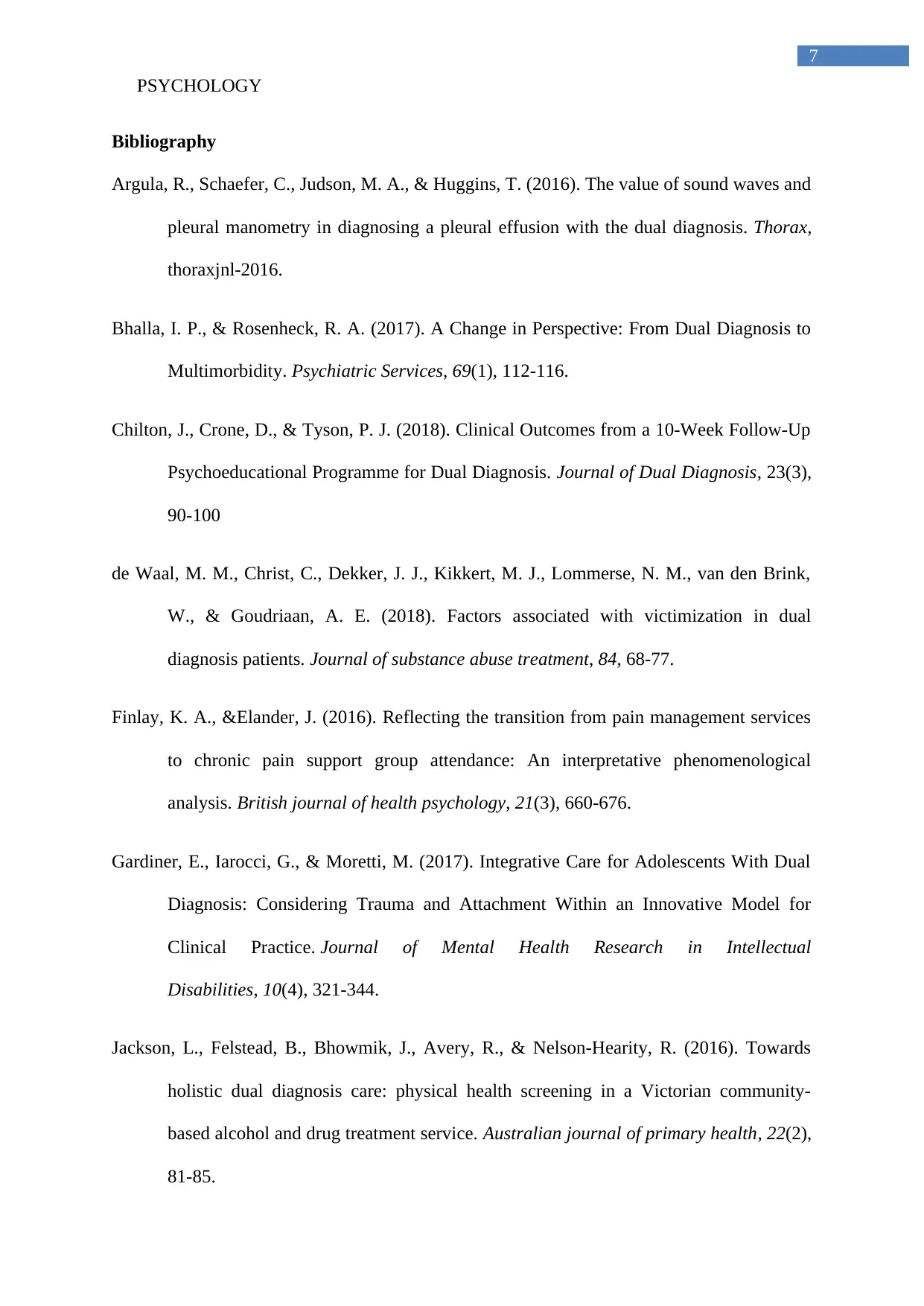
7
PSYCHOLOGY
Bibliography
Argula, R., Schaefer, C., Judson, M. A., & Huggins, T. (2016). The value of sound waves and
pleural manometry in diagnosing a pleural effusion with the dual diagnosis. Thorax,
thoraxjnl-2016.
Bhalla, I. P., & Rosenheck, R. A. (2017). A Change in Perspective: From Dual Diagnosis to
Multimorbidity. Psychiatric Services, 69(1), 112-116.
Chilton, J., Crone, D., & Tyson, P. J. (2018). Clinical Outcomes from a 10-Week Follow-Up
Psychoeducational Programme for Dual Diagnosis. Journal of Dual Diagnosis, 23(3),
90-100
de Waal, M. M., Christ, C., Dekker, J. J., Kikkert, M. J., Lommerse, N. M., van den Brink,
W., & Goudriaan, A. E. (2018). Factors associated with victimization in dual
diagnosis patients. Journal of substance abuse treatment, 84, 68-77.
Finlay, K. A., &Elander, J. (2016). Reflecting the transition from pain management services
to chronic pain support group attendance: An interpretative phenomenological
analysis. British journal of health psychology, 21(3), 660-676.
Gardiner, E., Iarocci, G., & Moretti, M. (2017). Integrative Care for Adolescents With Dual
Diagnosis: Considering Trauma and Attachment Within an Innovative Model for
Clinical Practice. Journal of Mental Health Research in Intellectual
Disabilities, 10(4), 321-344.
Jackson, L., Felstead, B., Bhowmik, J., Avery, R., & Nelson-Hearity, R. (2016). Towards
holistic dual diagnosis care: physical health screening in a Victorian community-
based alcohol and drug treatment service. Australian journal of primary health, 22(2),
81-85.
PSYCHOLOGY
Bibliography
Argula, R., Schaefer, C., Judson, M. A., & Huggins, T. (2016). The value of sound waves and
pleural manometry in diagnosing a pleural effusion with the dual diagnosis. Thorax,
thoraxjnl-2016.
Bhalla, I. P., & Rosenheck, R. A. (2017). A Change in Perspective: From Dual Diagnosis to
Multimorbidity. Psychiatric Services, 69(1), 112-116.
Chilton, J., Crone, D., & Tyson, P. J. (2018). Clinical Outcomes from a 10-Week Follow-Up
Psychoeducational Programme for Dual Diagnosis. Journal of Dual Diagnosis, 23(3),
90-100
de Waal, M. M., Christ, C., Dekker, J. J., Kikkert, M. J., Lommerse, N. M., van den Brink,
W., & Goudriaan, A. E. (2018). Factors associated with victimization in dual
diagnosis patients. Journal of substance abuse treatment, 84, 68-77.
Finlay, K. A., &Elander, J. (2016). Reflecting the transition from pain management services
to chronic pain support group attendance: An interpretative phenomenological
analysis. British journal of health psychology, 21(3), 660-676.
Gardiner, E., Iarocci, G., & Moretti, M. (2017). Integrative Care for Adolescents With Dual
Diagnosis: Considering Trauma and Attachment Within an Innovative Model for
Clinical Practice. Journal of Mental Health Research in Intellectual
Disabilities, 10(4), 321-344.
Jackson, L., Felstead, B., Bhowmik, J., Avery, R., & Nelson-Hearity, R. (2016). Towards
holistic dual diagnosis care: physical health screening in a Victorian community-
based alcohol and drug treatment service. Australian journal of primary health, 22(2),
81-85.
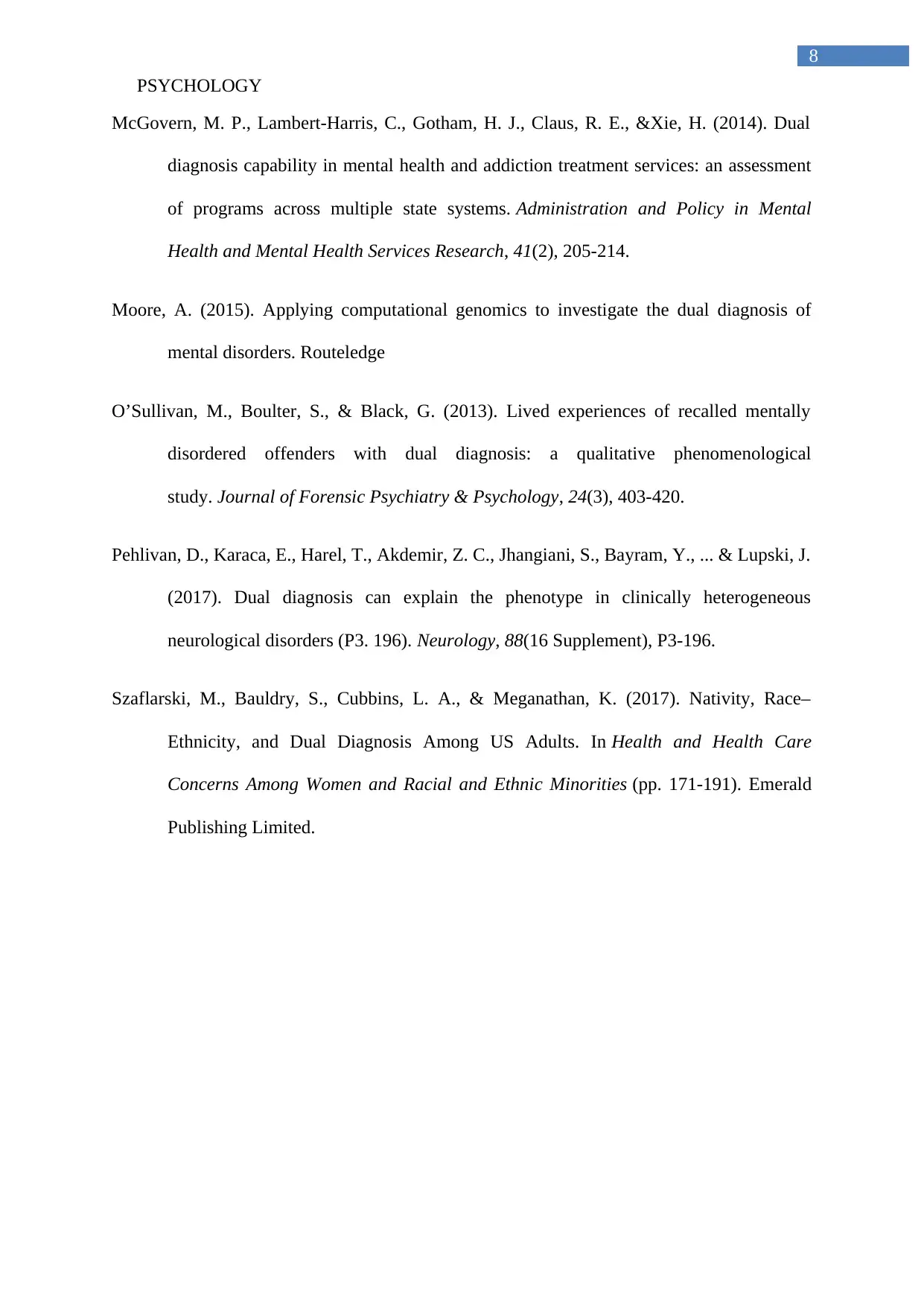
8
PSYCHOLOGY
McGovern, M. P., Lambert-Harris, C., Gotham, H. J., Claus, R. E., &Xie, H. (2014). Dual
diagnosis capability in mental health and addiction treatment services: an assessment
of programs across multiple state systems. Administration and Policy in Mental
Health and Mental Health Services Research, 41(2), 205-214.
Moore, A. (2015). Applying computational genomics to investigate the dual diagnosis of
mental disorders. Routeledge
O’Sullivan, M., Boulter, S., & Black, G. (2013). Lived experiences of recalled mentally
disordered offenders with dual diagnosis: a qualitative phenomenological
study. Journal of Forensic Psychiatry & Psychology, 24(3), 403-420.
Pehlivan, D., Karaca, E., Harel, T., Akdemir, Z. C., Jhangiani, S., Bayram, Y., ... & Lupski, J.
(2017). Dual diagnosis can explain the phenotype in clinically heterogeneous
neurological disorders (P3. 196). Neurology, 88(16 Supplement), P3-196.
Szaflarski, M., Bauldry, S., Cubbins, L. A., & Meganathan, K. (2017). Nativity, Race–
Ethnicity, and Dual Diagnosis Among US Adults. In Health and Health Care
Concerns Among Women and Racial and Ethnic Minorities (pp. 171-191). Emerald
Publishing Limited.
PSYCHOLOGY
McGovern, M. P., Lambert-Harris, C., Gotham, H. J., Claus, R. E., &Xie, H. (2014). Dual
diagnosis capability in mental health and addiction treatment services: an assessment
of programs across multiple state systems. Administration and Policy in Mental
Health and Mental Health Services Research, 41(2), 205-214.
Moore, A. (2015). Applying computational genomics to investigate the dual diagnosis of
mental disorders. Routeledge
O’Sullivan, M., Boulter, S., & Black, G. (2013). Lived experiences of recalled mentally
disordered offenders with dual diagnosis: a qualitative phenomenological
study. Journal of Forensic Psychiatry & Psychology, 24(3), 403-420.
Pehlivan, D., Karaca, E., Harel, T., Akdemir, Z. C., Jhangiani, S., Bayram, Y., ... & Lupski, J.
(2017). Dual diagnosis can explain the phenotype in clinically heterogeneous
neurological disorders (P3. 196). Neurology, 88(16 Supplement), P3-196.
Szaflarski, M., Bauldry, S., Cubbins, L. A., & Meganathan, K. (2017). Nativity, Race–
Ethnicity, and Dual Diagnosis Among US Adults. In Health and Health Care
Concerns Among Women and Racial and Ethnic Minorities (pp. 171-191). Emerald
Publishing Limited.
⊘ This is a preview!⊘
Do you want full access?
Subscribe today to unlock all pages.

Trusted by 1+ million students worldwide
1 out of 9
Related Documents
Your All-in-One AI-Powered Toolkit for Academic Success.
+13062052269
info@desklib.com
Available 24*7 on WhatsApp / Email
![[object Object]](/_next/static/media/star-bottom.7253800d.svg)
Unlock your academic potential
Copyright © 2020–2025 A2Z Services. All Rights Reserved. Developed and managed by ZUCOL.





